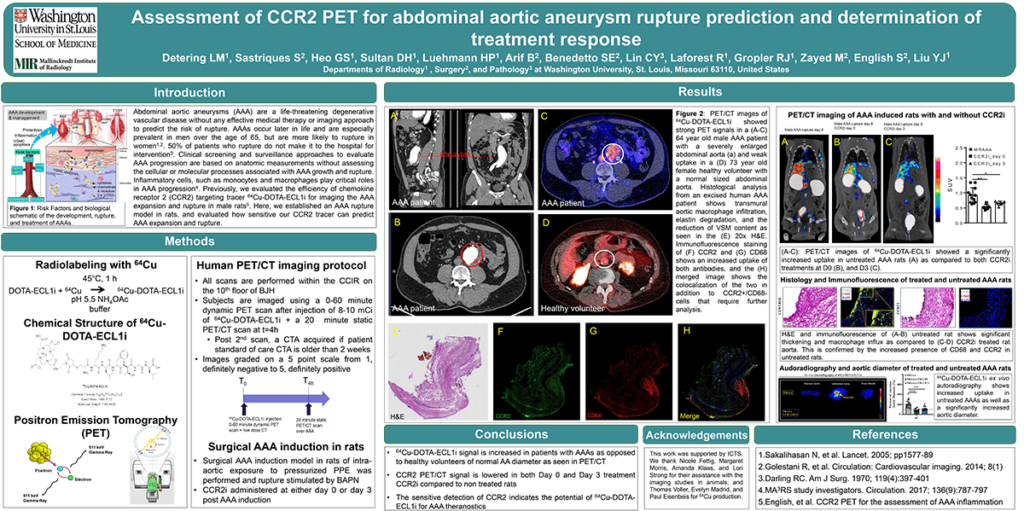Introduction: Abdominal aortic aneurysms (AAA) are a life-threatening degenerative vascular disease without any effective medical therapy or imaging approach to predict the risk of rupture. AAAs occur later in life and are especially prevalent in men over the age of 65, but are more likely to rupture in women. Previously, we evaluated the efficiency of chemokine receptor 2 (CCR2) targeting tracer Cu-DOTA-ECL1i for imaging the AAA expansion and rupture in male rats. Here, we established an AAA rupture model in rats, and evaluated how sensitive our CCR2 tracer can predict AAA expansion and rupture.
Methods: A surgical AAA induction model in rats of intra-aortic exposure to pressurized PPE was used. AAA rupture was stimulated by the administration BAPN. CCR2 antagonist was given via oral gavage at day 3 post AAA induction. Dynamic CCR2 PET/CT scans were performed in both antagonist treated and untreated AAA rats. Histopathology, immunostaining, tissue zymography, and ELISA techniques were used to evaluate AAA tissue post-mortem.
Results: Compared to rats with non-ruptured AAAs, CCR2 tracer uptake was significantly higher in ruptured male and female AAAs with no difference determined in the diameter of aneurysms. CCR2 inhibition significantly decreased the rupture rate for all the AAA rats at day 14 post treatment, as well as the CCR2 PET signals. Histopathology of treated AAA rats showed reduced inflammation, preserved elastic layers, minimal VSMC loss, and compensatory medial hypertrophy. Immunostaining showed decreased CD68+ macrophages and CCR2 expression. In AAA patients, Cu-DOTA-ECL1i PET/CT showed significant uptake in the aneurysm while low tracer retention was determined in healthy volunteers. Ex vivo human AAA tissue characterization demonstrated the elevated expression of CCR2.Impact: This project is diagnostic and investigative. CCR2 PET/CT signal appears to predict AAA risk of rupture in both sexes of rats, and may provide a basis of enhanced AAA surveillance in human patients with AAAs that are prone to rupture. The sensitive detection of CCR2 indicates the potential of Cu-DOTA-ECL1i for AAA theranostics.
Organization – Washington University in St. Louis
Detering LM, Sastriques S, Heo GS, Sultan DH, Luehmann HP, Arif B, Benedetto SE, Lin C, Laforest R, Gropler RJ, Zayed M, English S, Liu Y
